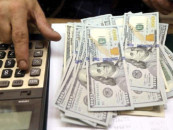How the debt issue remains circular in Pakistan
Resurgence of load-shedding portrays govt’s myopic aims

PHOTO: REUTERS
Pakistan to repay $6.5b debt over next 15 months
How can one ignore economics? The habit of absolute comparison tends to create a mirage. And when there is dominance of accounting mentality to run the affairs of economy, the situation gets worse since most of the comparisons are done on an absolute basis.
According to the finance ministry, the re-surfacing of circular debt of around Rs320 billion is causing long hours of load-shedding at frequent intervals.
Government spokespersons are providing various absolute comparisons. On the basis of absolute comparisons, they argue that the pace of accumulation of circular debt has slowed down.
The proof of burden is put on the determination of tariff by the National Electric Power Regulatory Authority (Nepra), showing that the difference between assumed and actual recovery of bills along with line losses created the circular debt in the energy supply chain.
The current secretary of the Ministry of Water and Power has made a case for increasing and releasing the Tariff Differential Subsidy (TDS) to ward off liquidity crunch. He stated that total subsidy allocation was budgeted at Rs118 billion, or 0.3% of Gross Domestic Product (GDP), in 2016-17 compared to Rs676 billion, or 2.4% of GDP, in 2012-13.
Basically, the government curtailed the TDS under the Extended Fund Facility (EFF) of the International Monetary Fund (IMF). In continuation, the government also increased electricity prices to a great extent to rein in the circular debt, though it compensated the consumers in the form of fuel price adjustment as international oil prices receded.
The electricity tariff was raised on the argument that the government has not kept pace with the ever increasing cost of oil prices since some experts suggest that pricing is the solution to the circular debt problem. However, experience tells that pricing is a partial solution to the problem.
The higher electricity tariff creates problems for most of the consumers and reduces the amount of receivables by electricity distribution companies (DISCOs).
The “unintended consequences” of higher electricity tariff is theft and other leakages in the context of Pakistan where the writ of the state is weak and political considerations do not allow the state to exert its influence.
The government is now fussing over governance or management problem to solve the issue of circular debt, which even provides a partial solution to the problem.
That is the reason the Ministry of Finance gives tough time to the Ministry of Water and Power and even the petroleum ministry in the release of allocated or supplementary amounts. This restraint normally creates tensions among the ministries, which led to petrol crisis in early 2015. The Ministry of Finance places restraints to meet the fiscal deficit target set by the IMF. Therefore, the government intends to restrict the budget deficit to 4.1% of GDP in 2016-17.
Pakistan’s external debt rises faster than foreign currency earnings
The government has tried to meet such quantitative targets to get the attention of the international financial press. This is done to finance the current account deficit through international capital inflows since lower budget deficits are praised by the international financial press.
However, this kind of financing has long-term deleterious consequences for capital development and welfare of the people. Putting the amount of circular debt in a holding company and creating artificial self-restraint to reduce the fiscal deficit would only put off the problem in future. By doing this, the government is rolling over its present commitments into future. This rolling over provides short-term political gain at the expense of medium to long-term economic loss.
The writer is Assistant Professor of Economics at SDSB, Lahore University of Management Sciences (LUMS)
Published in The Express Tribune, April 24th, 2017.
Like Business on Facebook, follow @TribuneBiz on Twitter to stay informed and join in the conversation.


















COMMENTS
Comments are moderated and generally will be posted if they are on-topic and not abusive.
For more information, please see our Comments FAQ